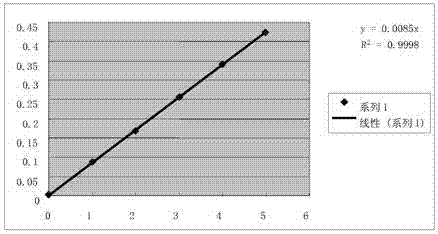Method for determining niobium content in titanium-niobium alloy
A titanium-niobium alloy and content technology, which is applied in the field of chemical analysis, can solve the problems that the detection method is not applicable, has not been disclosed, and is very different, and achieves the effect of clarification and stability of the sample solution.
- Summary
- Abstract
- Description
- Claims
- Application Information
AI Technical Summary
Problems solved by technology
Method used
Image
Examples
Embodiment 1
[0062] 3 sample test material
[0063] Weigh 0.0998 g sample material, accurate to 0.0001 g.
[0064] 4 Preparation of test solution
[0065] 4.1 Put the sample (3) in a 150 mL polytetrafluoroethylene beaker, add 5 mL of nitric acid (2.1), dropwise add 1 mL of hydrofluoric acid (2.3), heat at low temperature until the sample dissolves, cool slightly, add 20 mL of sulfuric acid (2.5), heat at low temperature until the volume of the solution is about 20 mL, remove it, transfer it into a 250 mL beaker, heat until sulfuric acid fumes are emitted, and heat until the first sulfuric acid fumes are emitted for about 3~4 minutes, take off the beaker and cool slightly, and then pour into the beaker Blow a small amount of water into the solution, heat until the second sulfuric acid fumes are emitted for about 2~3 minutes, cool, add 20 mL of tartaric acid solution (2.6), 5 mL of ammonium fluoride solution (2.7), boil for 2~3 minutes, remove, add Continue to boil 10 mL of saturated boric...
Embodiment 2
[0082] 3 sample test material
[0083] Weigh 0.1998 g sample material, accurate to 0.0001 g.
[0084] 4 Preparation of test solution
[0085]4.1 Put the sample (3) in a 150 mL polytetrafluoroethylene beaker, add 10 mL of nitric acid (2.1), dropwise add 2 mL of hydrofluoric acid (2.3), heat at low temperature until the sample dissolves, cool slightly, add 25 mL of sulfuric acid (2.5), heat at low temperature until the volume of the solution is about 20 mL, remove it, transfer it into a 250 mL beaker, heat until sulfuric acid fumes are emitted, and heat until the first sulfuric acid fumes are emitted for about 3~4 minutes, take off the beaker and cool slightly, and then pour into the beaker Blow a small amount of water into the solution, heat until the second sulfuric acid fumes are emitted for about 2~3 minutes, cool, add 20 mL of tartaric acid solution (2.6), 5 mL of ammonium fluoride solution (2.7), boil for 2~3 minutes, remove, add Continue to boil 10 mL of saturated boric...
Embodiment 3
[0102] 3 sample test material
[0103] Weigh 0.1502 g sample material, accurate to 0.0001 g.
[0104] 4 Preparation of test solution
[0105] 4.1 Put the sample (3) in a 150 mL polytetrafluoroethylene beaker, add 8 mL of nitric acid (2.1), dropwise add 2 mL of hydrofluoric acid (2.3), heat at low temperature until the sample dissolves, cool slightly, add 23 mL of sulfuric acid (2.5), heat at low temperature until the volume of the solution is about 20 mL, remove it, transfer it into a 250 mL beaker, heat until sulfuric acid fumes are emitted, and heat until the first sulfuric acid fumes are emitted for about 3~4 minutes, take off the beaker and cool slightly, and then pour into the beaker Blow a small amount of water into the solution, heat until the second sulfuric acid fumes are emitted for about 2~3 minutes, cool, add 20 mL of tartaric acid solution (2.6), 5 mL of ammonium fluoride solution (2.7), boil for 2~3 minutes, remove, add Continue to boil 10 mL of saturated boric...
PUM
| Property | Measurement | Unit |
|---|---|---|
| absorbance | aaaaa | aaaaa |
| absorbance | aaaaa | aaaaa |
Abstract
Description
Claims
Application Information
 Login to View More
Login to View More - R&D
- Intellectual Property
- Life Sciences
- Materials
- Tech Scout
- Unparalleled Data Quality
- Higher Quality Content
- 60% Fewer Hallucinations
Browse by: Latest US Patents, China's latest patents, Technical Efficacy Thesaurus, Application Domain, Technology Topic, Popular Technical Reports.
© 2025 PatSnap. All rights reserved.Legal|Privacy policy|Modern Slavery Act Transparency Statement|Sitemap|About US| Contact US: help@patsnap.com



